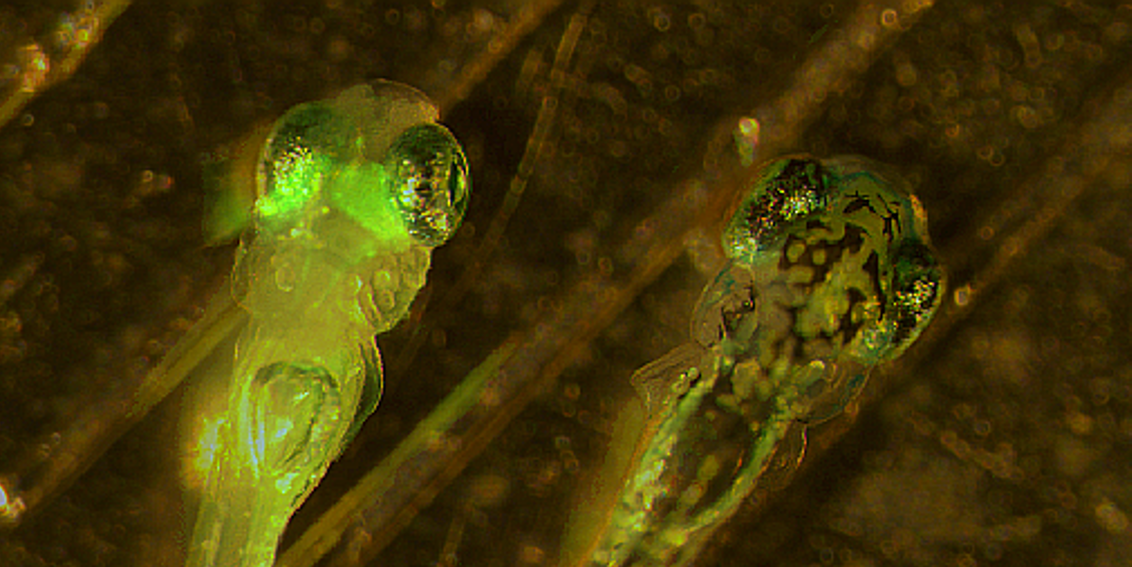Visual Neurons’ Inhibitory Signals Identified as Protection Against Overstimulation, Study Finds
When the eye jumps from one point to another, the image of our surroundings rapidly passes across the retina and triggers a wave of neuronal activity. In order not to be overwhelmed by the sensory impressions produced by our own movements, the brain suppresses processing of the stimuli as this happens. Now, researchers headed by Freiburg neuroscientist Professor Johann Bollmann have for the first time measured the signals that do this at a cellular level in zebrafish larvae. Their results have been published in Nature Communications.
Rather than moving at a steady speed, zebrafish larvae swim in erratic bouts. During these brief periods of movement, their brain filters out visual impressions so that they are not perceived. The researchers verified this by recording the activity of neurons in the top of the midbrain, the tectum. This tectum is the region of the brain where the fish process what they see. While the fish larvae moved around, some of these neurons transmit fewer signals. By measuring the electrical influx in individual nerve cells, the scientists were able to show that this reduced activity was preceded by brief impulses from inhibitory synapses. These inhibitory impulses briefly alter the electrical properties of the cell envelope so that the cells react less to the simultaneously occurring excitatory signals from the retina and therefore themselves emit fewer signals.

Zebrafish larvae with (left) and without (right) green fluorescing protein in the areas of the brain (tectum) that process visual information. Photograph: Johann Bollmann.
Precise origin of inhibitory signals still uncertain
To discover the source of the inhibitory signals, the researchers also investigated the local neuronal activity in a cross-section of the tectum. This involved them taking zebrafish larvae whose neurons contain a genetically-coded fluorescent dye that is sensitive to calcium and therefore glows in the fluorescence microscope when there are raised concentrations of calcium cations (Ca2+). Such a raised Ca2+ concentration always occurs if information is transmitted from neuron to neuron via synapses. If these fluorescence signals occur immediately before the swimming motion, then excitatory synapses are most probably triggering those neurons that control the movement. If, however, these fluorescence signals only occur after the larvae has begun to swim, it is more likely to be those synapses that have an inhibitory effect on the controlling neurons. The recordings in the cross-section show that inhibitory signals are almost exclusively sent in the upper layers of the tectum. These layers mainly contain offshoots of nerve cells from a neighbouring region of the tectum, which receives among other things signals from areas of the cerebellum. So the scientists also studied the activity of the cells in this neighbouring region. Here too they found higher increases in Ca2+ concentrations immediately after rapid swimming motions, and although this is not yet clear evidence that the inhibitory signals originate here, the measurements offer a basis for future research.
Zebrafish larvae are a wide-spread modelling system in developmental biology and neurobiology, as they are only a few millimetres long and transparent, and the activity in their neurons can in principle be measured at high resolution in all areas of the brain. Their brains are of relatively limited complexity: similar to the brain of fruit flies, zebrafish larvae only have 100,000-200,000 neurons. At the same time, the structure of their nervous system is similar to that of other vertebrates, and as a result basic brain functions can be studied in a simple modelling system. Therefore, the neuroscientists believe that their findings may in part be translated to processes in the human brain. “With our measurements we have for the first time visualised signals at cell level that protect against overstimulus by rapid movement,” says Bollmann. “This is an important step towards a better understanding in future of how precisely the brain distinguishes between stimuli from locomotion and those from outside. Mechanisms such as these whereby the brain incorporates its own actions into the processing of external sensory impressions will probably play a major part in the formation of complex internal models of our surroundings in the brain.”

